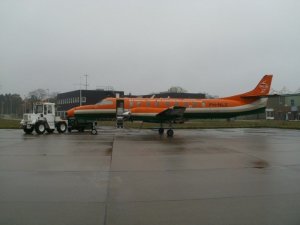The four Galileo satellites in orbit have achieved their first aerial fix of longitude, latitude and altitude, marking the first time ever that Europe has been able to determine the position of an aircraft using only its own independent navigation system.
This milestone took place on a Fairchild Metro-II above Gilze-Rijen Air Force Base in the Netherlands at 12:38 GMT on 12 November 2013.
It came as part of an aerial campaign overseen jointly by ESA and the National Aerospace Laboratory of the Netherlands, NLR, with the support of Eurocontrol, the European Organisation for the Safety of Air Navigation, and LVNL, the Dutch Air Navigation Service Provider.
A pair of Galileo test receivers was used aboard the aircraft, the same kind currently employed for Galileo testing in the field and in labs across Europe. They were connected to an aeronautical-certified triple-frequency Galileo-ready antenna mounted on top of the aircraft.
NLR’s Fairchild Metro-II is something of a satnav veteran, having previously performed initial European GPS testing back in the 1980s and the first tests of EGNOS.
Tests, scheduled during periods when all four Galileo satellites were visible in the sky, covered both Galileo Open Service (OS) and the more precise, encrypted and limited to governmental entities Public Regulated Service (PRS).
Flights covered all major phases: take off, straight and level flight with constant speed, orbit, straight and level flight with alternating speeds, turns with a maximum bank angle of 60º, pull-ups and push-overs, approaches and landings.
They also allowed positioning to be carried out during a wide variety of conditions, such as vibrations, speeds up to 456 km/h, accelerations up to 2 ghorizontal and 0.5–1.5 gvertical, and rapid jerks. The maximum altitude reached during the flights was 3000 m.

